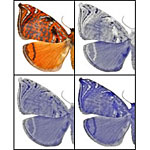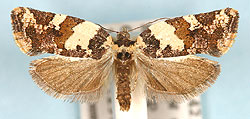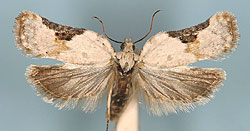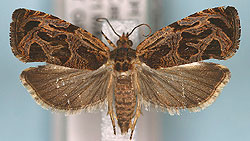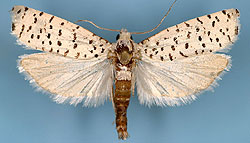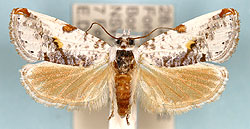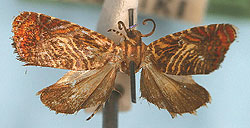
| home | catalogue | host plants | library | TORTS | tortriciDNA | about | site map |
|
Superfamily TORTRICOIDEAFamily TORTRICIDAEThe Tortricoidea is one of the most diverse superfamilies in the microlepidoptera, second only to the Gelechioidea in number of described species (Horak 1998). It contains a single family, Tortricidae, which is composed of over 10,300 species in approximately 1,050 genera (see current numbers here). Tortricid adults are characterized by a combination of the following characters: head rough-scaled above; scaling of lower frons short, appressed and upwardly directed; proboscis well developed and unscaled; labial palpi three-segmented and generally held horizontally or porrect, with apical segment short and blunt; maxillary palpi reduced; ocelli and chaetosema present; ovipositor lobes flat (Horak 2006). The structure of the female ovipositor is the only single apomorphy that unites the entire family. Tortricidae is divided into three subfamilies: Tortricinae, Olethreutinae, and Chlidanotinae (Horak 1998). The family has been recently catalogued (Brown 2005), and an updated online database of generic and species names along with their synonyms is available (T@RTS). Phylogenetic relationships surrounding the Tortricidae are only recently investigated. Tortricids are included in the non-obtectomeran Apoditrysia, and have been hypothesized to be related to the Cossoidea or the Cossoidea + Sesioidea by various authors (Common 1990, Horak and Brown 1991, Horak 1998). A recent molecular study using five protein-coding nuclear genes to determine relationships within the Ditrysia failed to consistently place the Tortricoidea within the Lepidoptera, although the superfamily was consistently recovered as monophyletic (Regier et al. 2009). Subfamily TortricinaeThe subfamily Tortricinae contains 11 tribes (Horak 1998). Both the Tortricinae and Chlidanotinae share a combination of the following characters that separate them from the Olethreutinae:
Although they share many of the same characters, the Chlidanotinae can be separated from the Tortricinae by the structure of the male and female genitalia. Some representative Tortricinae are depicted below:
Most authors agree that the Tortricinae is paraphyletic, and the status of this subfamily may be better understood with future molecular study. A brief summary of the 11 tribes contained within the subfamily is given below (summarized from Horak 1991 & 1998, Brown et al. 2011). Tribe PhricanthiniThe Phricanthini contains approximately 20 species that are distributed in Australia, Asia, and Madagascar. Members of this group feed exclusively on plants in the Dilleniaceae, an uncommon example of larval host specialization within the family. Synapomorphies within the group include the following: sclerotized socii; inwardly projecting modified setae on male abdomen; larva with SD1, SD2, and spiracle on the same pinaculum on A1-8. Tribe ArchipiniThe Archipini is the largest tribe within the Tortricinae, with more than 1,600 described species in 150 genera. Its members are present in all regions but are uncommon in the neotropics. Most are polyphagous leafrollers, and this tribe contains many pests, such as the light brown apple moth (Epiphyas postvittana Walker). A synapomorphy for the group is the dagger-shaped signum in the female corpus bursae. Tribe EpitymbiiniThe Epitymbiini is found only in Australia where its approximately 100 members feed on eucalyptus leaf litter (Myrtaceae). There is speculation that members of the Epitymbiini are simply archipines with specialized feeding habits, as no morphological characters separate the two tribes. Tribe SchoenoteniniThe Schoenotenini consists of approximately 200 species that occur primarily in the Oriental and Australian regions. Larvae of the group have a variety of feeding habits. Adult synapomorphies include the development of the M-vein within the forewing cell and modified chaetosemata. Tribe AtteriiniThe Atteriini is a small tribe consisting of roughly 50 species. Most are Neotropical, and little is known regarding their larval habits. Synapomorphies for the group include elaborate scaling on the female forewing. Tribe EuliiniMost of the 670 members of this tribe occur in the Neotropics. Like the Atteriini, the larval stages of most species are poorly known. A possible synapomorphy for the tribe is the presence of a hair pencil on the base of the male femur. Tribe SparganothiniThis tribe contains approximately 240 members that occur mostly in the New World. The larvae are polyphagous leafrollers. Male Sparganothini are characterized by large, scaled, lobed socii and a gnathos that is rudimentary or fused with the socii. Tribe CochyliniThis is a large tribe with more than 1,000 described species. The Cochylini occur in all faunal regions, but are primarily Holarctic and Neotropical. The larvae are internal feeders in roots, stalks, and seeds. Synapomorphies for the group include wing pattern and venation and the structure of the male genitalia. Tribe CnephasiiniThe Cnephasiini contains approximately 250 species that are distributed throughout the Holarctic. The larvae of this group feed within webbed or spun leaves. Synapomorphies for the group include a spined uncus, floricomous ovipositor, band-shaped signum, and a 12-carbon pheromone (usually restricted to olethreutines). Tribe CeraciniThe Ceracini is a small tribe of approximately 30 species. They are primarily Oriental, occuring in Japan and Malaysia. The larvae are leaf rollers. Synapomorphies for the tribe include a pupa without dorsal spines, the arrangement of the tarsal setae in the larvae, and an ostium that is not connected with the anterior apophyses in the female genitalia. Tribe TortriciniThe 400 members of the Tortricini are primarily Holarctic and Oriental. The females oviposit eggs singly, and the larvae are leafrollers. Synapomorphies for the group include a modified juxta-anal tube complex. Subfamily OlethreutinaeThe subfamily Olethreutinae contains 6 tribes (Horak 2006), and its members are more widely distributed in the Northern Hemisphere. This is the second largest of the three Tortricid subfamilies. Several characteristics of the Olethreutinae are:
Some representatives of the subfamily are depicted below:
Most authors agree that the Olethreutinae is monophyletic. A brief summary of the 6 tribes contained within the subfamily is given below (summarized from Horak 1991, 1998, & 2006). Tribe MicrocorsiniThe Microcorsini is a small tribe consisting of approximately 45 species in two genera (Cryptaspasma and Collogenes). This is the most basal group within the Olethreutinae. The larvae are borers in hard nuts. Synapomorphies for the group includes anterior apophyses connected to the sterigma and horn-shaped signa. Tribe BactriniThis tribe contains over 150 species that are distributed worldwide. The larvae are stem borers in Juncaceae, Cyperaceae, and Gramineae. Synapomorphies for the group include a modified sacculus and anteriorly invaginated sterigma. Dang (1990) included the former tribe Endotheniini in the Bactrini. Tribe OlethreutiniThis is a large group, containing over 1,100 described species. Its members occur worldwide, although the greatest diversity is in SE Asia and the Holarctic. The larvae are mainly leafrollers. There are no synapomophies that define the entire tribe, although a hindwing with veins M3 and CuA1 separate and a sacculus with two clusters of spines unite some species. Horak (2006) included the former tribe Gatesclarkeanini as the Gatesclarkeana group within the Olethreutini. Tribe EucosminiThe Eucosmini is another large tribe, with approximately 1,650 described species. Their greatest diversity is in the Holarctic, although members of the tribe occur worldwide. The larvae are leaf-rollers, leaf-webbers, or stem and root borers. One potential synapomophy for the tribe is the base of vein M2 bent towards the stalked base of veins M3 and CuA1 in the hindwing. Tribe EnarmoniiniThis tribe consists of approximately 300 species. The Enarmoniini is distributed worldwide, although their greatest diversity is in the Australian and Oriental regions. The larvae are leaf-rollers or stem and root borers. There is no set of characters that defines the entire tribe; potential synapomorphies include forewing shape, fused socii, and deciduous cornuti. Tribe GrapholitiniThe Grapholitini contains approximately 900 species with a worldwide distribution. The larvae are borers in fruits, roots, and shoots, and this group contains many pest species. Synapomorphies for the tribe include a hindwing with veins M2 and M3 widely separated at the base and a reduced dorsal complex in the male genitalia. Subfamily ChlidanotinaeThe subfamily Chlidanotinae consists of three tribes found mainly in the Neotropics and Australia. They share a combination of characters with the Tortricinae, although structures of the genitalia, such as a deep dorso-longitudinal invagination of the valvae in the male genitalia, can be used to separate the Chlidanotinae. Some representatives of the subfamily are depicted below:
The following tribes are included in the Chlidanotinae, which appears to be monophyletic: Tribe PolyorthiniThe Polyorthini contains approximately 140 species that are distributed primarily throughout the Neotropics and Oriental/Australian regions. The larvae are leaf-rollers or stem borers. Synapomorphies for the tribe include the shape and structure of the valvae and anellus. Tribe ChlidanotiniAround 75 species are contained in this tribe, which is distributed throughout the Neotropics and Oriental/Australian regions. The larvae are internal feeders. The group is defined by modified, distally compressed antennae as well as wing venation. Tribe HilarographiniThe pantropical Hilarographini contains approximately 70 species. The known larvae are stem borers. Synapomorphies include slender, smooth, upcurved palpi, large ocelli, and ciliate male antennae.
ReferencesBaixeras, J., J. W. Brown and T. M. Gilligan. 2008. T@RTS: Online World Catalogue of the Tortricidae (Version 1.2.1). http://www.tortricidae.com/catalogue.asp. Brown, J. W. 2005. Tortricidae (Lepidoptera) In World Catalogue of Insects 5:1-741. Apollo Books, Stenstrup, Denmark. Brown, J. W., J. Baixeras and C. Mitter. 2011. Taxon: Tortricidae. Leptree.net. http://www.leptree.net/lep_taxon_page/Tortricidae/view. Common, I. F. B. 1990. Moths of Australia. Melbourne University Publishing. 535 pp. Horak, M. 1991. Morphology, pp. 1-22. In L. P. S. van der Geest, H. H. Evenhuis (eds.), Tortricid Pests: Their Biology, Natural Enemies and Control. Elsevier, Amsterdam, The Netherlands. Horak, M. 1998. The Tortricoidea, pp. 199-215. In N. P. Kristensen (ed.), Handbook of Zoology, Lepidoptera, Moths and Butterflies, Vol 1: Evolution, Systematics, and Biogeography. Walter de Gruyter, Berlin, New York. Horak, M. 2006. Olethreutine moths of Australia (Lepidoptera: Tortricidae). Monographs on Australian Lepidoptera, Vol. 10. 522 pp. Regier, J. C., A. Zwick, M. P. Cummings, A. Y. Kawahara, S. Cho, S. J. Weller, A. D. Roe, J. Baixeras-Almela, J. W. Brown, C. S. Parr, D. R. Davis, M. E. Epstein, W. Hallwachs, A. Hausmann, D. H. Janzen, I. J. Kitching, M. A. Solis, S.-H. Yen, A. Bazinet and C. Mitter. 2009. Toward reconstructing the evolution of advanced moths and butterflies (Lepidoptera: Ditrysia): an initial molecular study. BMC Evolutionary Biology 9: 280. |
Please do not download, copy, print, or otherwise distribute any images from these
pages without the permission of the author. Contact Form.
